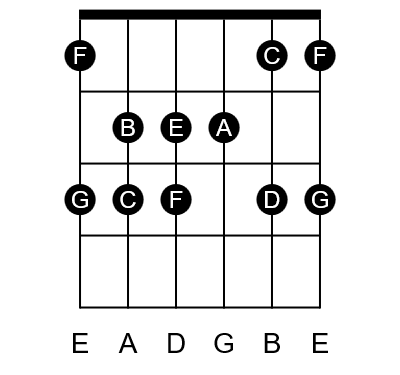
With very basic guitar playing, you don’t normally play notes between chords. Instead, you simply switch from one chord to the next.
As you become more comfortable with the guitar, you may start getting a little bored with that style of playing. You might start to feel like all the songs you play sound the same.
When that happens, you need to spice things up a bit. To do that, you can play notes between chords.
What does it mean to play notes between chords?
Songs are usually made up of a progression of chords played on guitar, piano, or other instruments. Instead of switching from one chord to the next with no connection between them, the musician can stop playing one chord a little early to leave space between that and the next chord. Then the space can be filled with note melodies that connect the first chord to the second.
Many examples of this can be found in the playing of famous guitarists. The name most often mentioned is Jimi Hendrix. But many other players use this technique. Players like Stevie Ray Vaughan, Eric Clapton, John Mayer, and the list goes on.
But it’s not just the rock and roll guitar gods that do it. Folk guitarists do it. Country players. Well, I guess you get the idea. It doesn’t matter what genre of music you play, you can use the same technique and play notes between chords.
How do you learn to play notes between chords?
If so many players use this technique, there must be something to it, right? So you should learn the technique. And you can get as simple or as sophisticated as you like.
We’ll start with some simple ideas. Once you understand the concept and can execute a few simple examples, you’ll be able to explore on your own and come up with all kinds of interesting ideas.
First step: become comfortable with the chord progression
I guess it seems obvious, but it’s important to make the point. Before you can successfully play notes between chords, you must first be completely comfortable with the chord progression you’re playing. You need to develop the ability to nearly effortlessly switch between the chords of the song.
Need some easy chords to start with? Read
If you’re struggling just to make your chord changes, you won’t have success with playing notes between chords. There’s no shame in that. It’s just a matter of skills development. I’m not judging. Rather I’m simply encouraging you to take things in their proper order.
Take the time to learn how to change chords effortlessly and smoothly. Get so good at doing so that you don’t need to think about it. Once you’ve accomplished that, you’re ready for the next step.
Second step: understand your scales
You’ll often hear people argue about learning scales. Some people will tell you that spending time leaning your scales on guitar is just busy work. They’ll say things like, “Don’t waste your time learning scales and theory. It only holds you back.”
Well, to put it bluntly, those people are full of…unfortunate thinking.
I get it. To an extent these people have a point. You don’t want to get so bogged down in scale practice that you never actually make any music. If all you ever do is play scales, you’ll never really become a player.
But at the same time, if you don’t understand your scales, you miss out on so much musical possibility. Once again, the key is balance. Don’t spend all your time running scales. It’ll drive you mad. But don’t ignore the valuable understanding that scales provide you.
Quite simply put, if you want to play notes between chords, it helps tremendously to understand scales and the notes that belong to them.
Need to know more about scales? Read
The important scales for you to start with are the major and minor scales and their pentatonic versions. With these four scales you can play a huge variety of interesting connections between chords.
Obviously, if your song is in a major key, use the major scale or the major pentatonic scale. In a minor key song, use the minor scale versions.
Third step: create space and fill it with notes
Once you understand your chord progression and you have mastery of your scales, you’re really ready to play notes between chords.
First, you need to create some space for the notes you want to play. Then you will fill that space with your note melodies.
You can start simply. For instance, say the chord progression calls for one measure of the first chord. On the second bar you switch to the next chord. We’ll assume the song is in 4/4 time, so there are four beats to each measure.
If you were to just play chords, you’d strum that first chord for the entire measure. Then, on the first beat of the next measure you’d change to the second chord.
Instead, to play notes between the chords, play the first chord for three beats of the first measure. For now, just leave silence on beat four and then play the second chord on beat one of the next bar.
It sounds a bit weird to just stop for that beat, but you’ve just created the space you need for one or more notes to play between the chords.
Now do the same thing again, but this time instead of leaving that one beat empty with silence, play a note from the scale of the key the song is in during beat four of the first measure. That’s really all there is to it!
Of course, you can fill the space with as many notes as you’d like. And you can make the space longer or shorter to create variety. But the concept remains just that simple. Create space between the chords and then fill that space with notes.
A practical example of playing notes between chords
Let’s take a look at a simple example that will make it clear and get you started.
We’ll use the chords C and Am. It’s common to move from one of those chords to the other in countless songs. And you can easily connect those two chords with one single note.


Know what scale to use
If the song calls for these two chords, it’s a good bet that the song is in the key of C major or A minor. Because A minor is the relative minor of C major, those two keys share exactly the same notes. The notes of C major are:
C, D, E, F, G, A, B
And the notes of A minor are
A, B, C, D, E, F, G
Exactly the same notes. Just in a different order.

So, when you switch between these two chords, you can choose any of the notes in the C major scale to connect them.
Since the C chord uses the note C for its root note and the Am uses the A note for its root, you really won’t use those two notes for a simple connection between the chords. You can sort of think of those two notes as your starting and ending points.
That leaves you with the notes B, D, E, F, and G. Any of those notes will work to make the connection between the two chords. Some will work better than others.
To be clear, as you get more sophisticated with this technique you might indeed use the C and A notes as well as the others, but for now let’s keep it simple.
The easiest connection between C and Am
For the easiest connection between these chords, look back at the chord charts for C and Am and the C major scale above. Notice the relationship on the guitar between the root notes of the two chords. The C root note sits at fret 3 of the A string. And you find the root of Am at the open A string.
You might have already noticed that the only note of the C major scale that sits between these two notes is the B note you find at fret 2 of the A string. So that makes the most natural connection possible between these two chords.
Try it now. Play your C chord for three beats of the first measure. On beat four, instead of playing the C chord, play just the B note. Then on beat one of the next measure, switch to the Am.
Notice how smoothly that B note leads from the C to the Am. Pretty cool, right?
And it works in the other direction too. You can play that note from the Am back to the C.
Try it. Play back and forth between the C and the Am. One measure of C, then to Am for a measure, then back to C, back to Am, and just keep it going.
When you’re ready, start substituting that B note on beat four of every measure. Notice how that note beautifully leads you from either chord to the other.
Mix it up with other notes from the scale
As cool as this is using the B note, it won’t be long before you start getting bored with it. If you do the same thing over and over and over in music, it’s going to start getting monotonous no matter how cool it was to begin with.
So, to break that monotony, choose some of the other notes from the scale to play instead of the B note.
For instance, when you move from the C to the Am, play the G note at fret 3 of the Low E string instead of the B note. Then, when moving back to the C from Am, play the E note that you’re already fretting at fret 2 of the D string.
Notice the different feel it gives to your song as you choose different notes. Even just this simple technique is already making your playing far more interesting!
Explore other ideas
Once you have this simple one-note connection mastered, it’s time to branch out. Explore other possibilities and you’ll be amazed at what you come up with.
For instance, instead of playing just one quarter note between the two chords, try two eighth notes. Like, maybe play a G eighth note followed by a B. What does that sound like? Do you like it? Then do it again! If you don’t like it, well, now you know not to use that move.
Now try a different timing. Instead of creating a one-beat hole to fill with notes, try filling a two-beat hole with a combination of notes.
Once you’ve come up with a few ways you like to play notes between chords, mix it up. In the first measure fill a one-beat hole with that B note. Then in another measure, fill it with a G note. In yet another bar, fill a two-beat hole with four eighth notes.
Next, try playing more than one note at a time. Experiment with pull-offs, hammer-ons, bending, and sliding. Pull out all the stops!
The point is that the possibilities are endless here. Try a bunch of stuff. Find the ones you like and mix them up to keep your playing active and interesting.
For a more structured, specialized approach, read
Play notes between different chords from the key too
Of course, C and Am aren’t the only chords that this technique works for. In fact, you can use it between virtually any two chords.
The chord G is another chord in the key of C. Play a progression that moves from C to Am to G and back to C. Just like before, you can use any of the notes of C major to connect all of these chords. Try it and see what you can come up with.
As you add different chords, you’ll notice that you have to be a little more selective about which notes you use. Although technically any note from the scale should work, some sound better than others depending upon the chords you’re moving between.
Just keep experimenting. Soon you’ll begin to develop a feel for your favorite chord connectors based on the chords you’re moving to and from.
Connect any chords in any key
While we’ve walked through a simple example in the key of C, you can play notes between chords in any key. You just need to understand what notes you can play that will sound good.
This is where your knowledge of scales come in. If you’re in the key of G, then you’ll use the notes from the G major or G major pentatonic scales. In the key of Bbm, you’ll use the notes from that key.
It’s honestly not as overwhelming as it seems. Keep practicing the technique in a variety of keys and you’ll soon get a great feel for what notes connect any two chords together.
A great way to practice this technique is to find the chord charts to some of your favorite simple songs. Play along with the chords until you’ve got the chord changes nailed so that you no longer have to think about them. Then, start creating holes between the chords and filling those holes with notes from the song’s key scale.
Start slowly and simply. You’ll make fast progress once you get going.
Should you always play notes between chords?
Of course by now you know the answer. Sometimes you’ll just want to play chords. That’s OK.
Maybe you just want to strum along to provide a group of friends accompaniment while you sing around the campfire. You don’t need to show off.
But other times, you want to play something more interesting. For example, if you’re performing and everyone is focused on you and your playing, you may soon start to feel self conscious about the simplicity of just strumming through chords.
Just as with everything you learn on guitar, don’t think in terms of requirements. You don’t have to do anything all the time. This applies to whether you should play notes between chords. Use your discretion.
If you never play notes between chords, your playing can seem boring. On the other hand, if you always play notes between chords, your playing can begin to sound overly busy and yet repetitious. The best approach is usually to create variety. Mix it up. Sometimes play notes between chords. Other times leave those extra notes out.
Part of making great music is to keep your listener guessing. Bore them and you’ll lose them. Tire them out by over playing and you’ll also lose them. Keep them guessing and you’ll hold their interest.
Conclusion
Sometimes simply strumming through chords can get boring. So what can you do to make things more interesting? You can play notes between chords.
The concept is actually quite easy. You just need to know a couple basic techniques to start adding interest to your chord progressions.
Start with mastering the chord progression for your song. Then, understand the song’s scale. Create holes in the chord progression and fill them with notes from the scale.
With a bit of practice, you can take your playing from simple sounding to a place where your listener starts to believe you’re a better player than you probably give yourself credit for!

Gary,
Well done – really a basic building block
on the road to chord melody.
Bill
Thanks, Bill. I’m glad you found it helpful. (Sorry for the slow response…somehow I missed your comment!)
Been playing for several years and wanted to start spicing up my guitar playing. This little tutorial by Gary really helped me understand the concept of notes between chords and how to apply the concept. Great job, Gary!
Thank you, Charley. It means a lot to me to know you found it helpful!
I’ve been playing and singing mostly country songs for a decade with the same “boom-chuck” strumming. I don’t know how to play an interesting instrumental between verses. It doesn’t take long for my playing to get boring.
I’m going to try this and experiment. I’d like to hear more about this concept. Is there more on this?